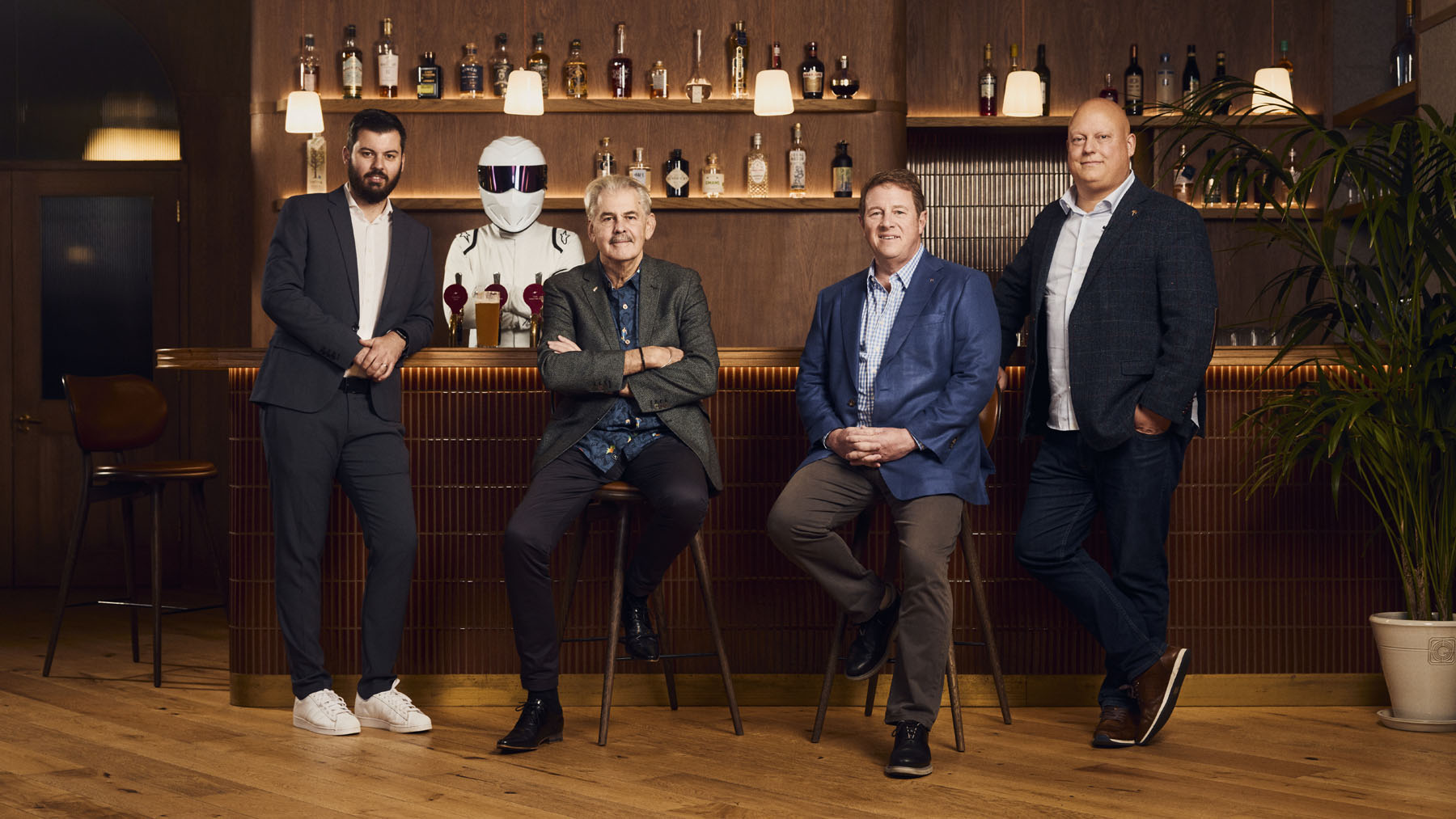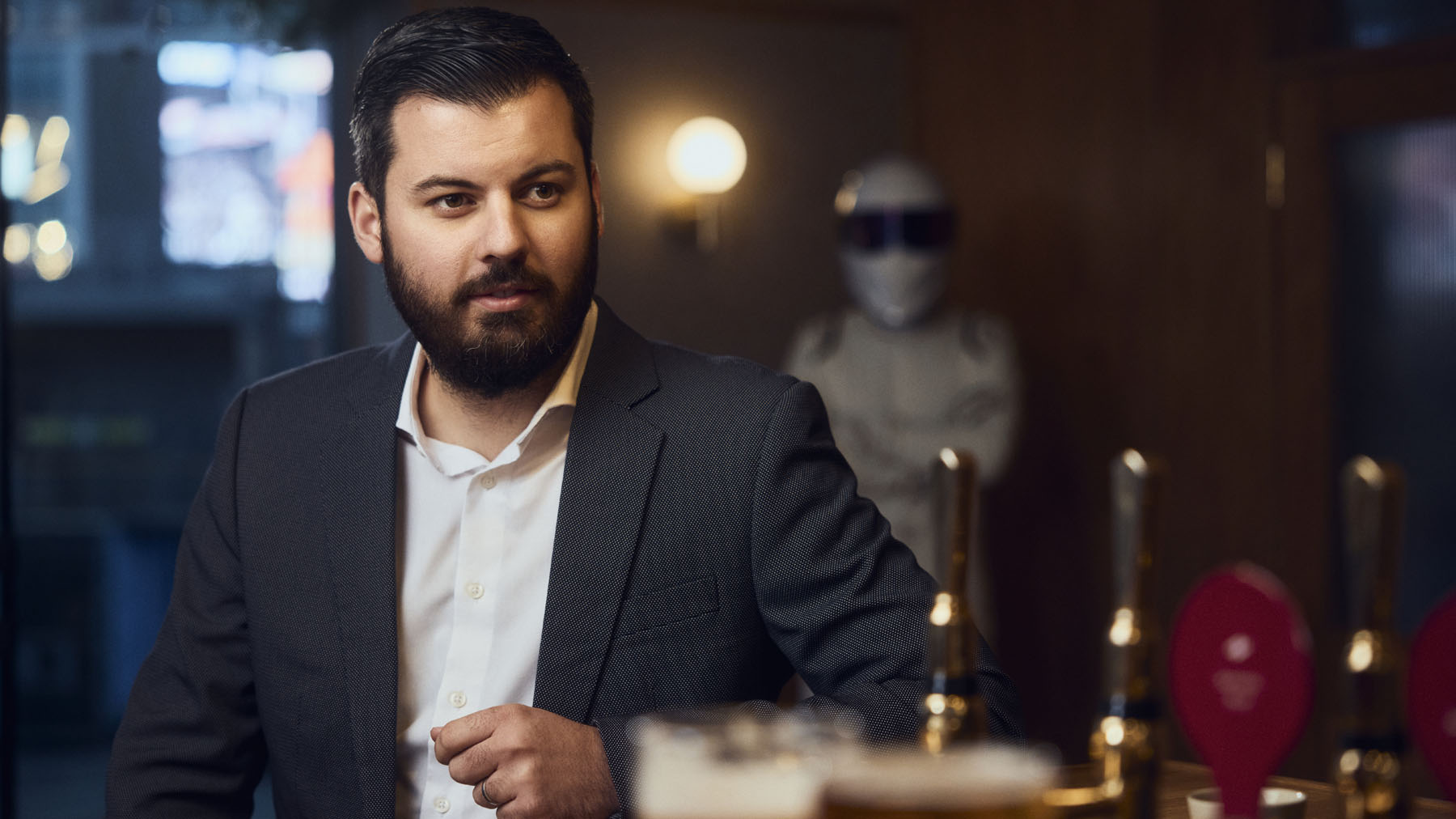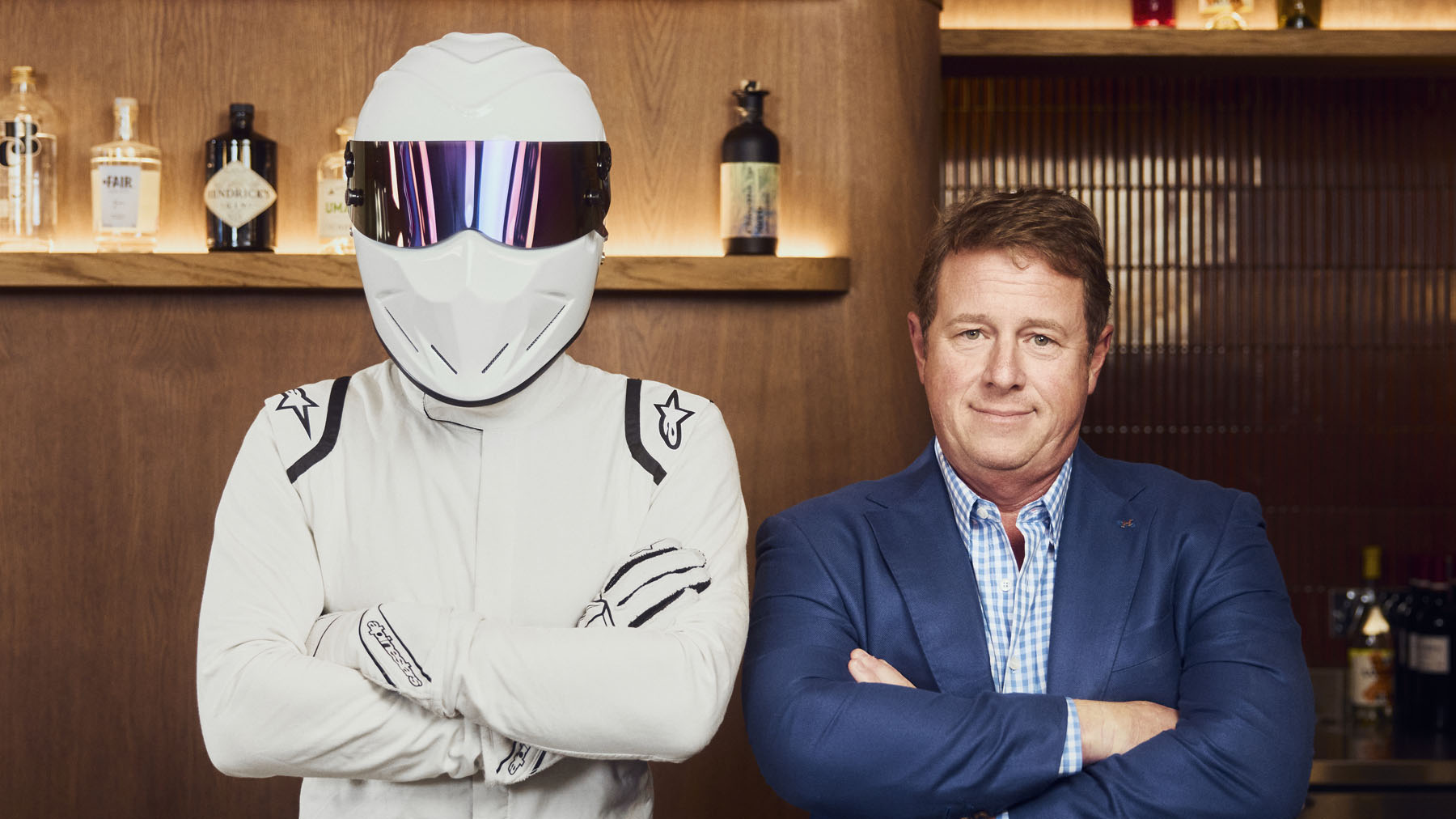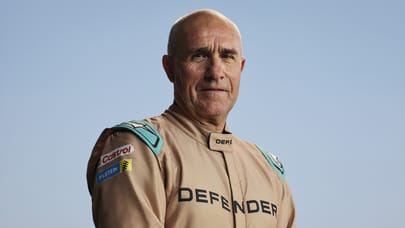
Boss Level: in conversation with Koenigsegg, Murray, Rimac and Hennessey
Put four great performance car minds in the same room, toss in some random topics and you have yourself a conversation for the history books
Gordon arrives first, a little early, catches us off guard. Not that he cares, he’s casual and confident, happy to strike up a chat with whoever’s nearest – hands in pockets, loose-fitting blazer over colourful untucked shirt. His punctuality makes sense, the other three have a combined 6,761 miles of travel to get here, Surrey-based Gordon has 28. Mr Hennessey barrels in next – big smiles, even bigger handshakes, thick Texas charm. He and Gordon gravitate towards each other, I flap about trying to find them both a glass of sparkling water – bit too early for a cocktail.
Things are going well. Two of our four star guests have arrived, brawling between rival factions of the performance car elite has yet to materialise, and despite Masterchef final levels of stress there’s hope we might pull this off.
Christian von Koenigsegg rocks up with a small TV crew in tow. They’re filming a documentary on the great hypercar entrepreneur for Swedish TV and thought this might be interesting to include. We shall see. More handshakes, nods, introductions, another sparkling water. A lock-in is looking unlikely.
Photography: Tom Barnes + Huckleberry Mountain
So it’s Mate Rimac bringing up the rear – not a power move from the 34-year-old whippersnapper, his PR assures us, but sticky traffic on the A40. In he comes, suit, no tie, trainers and orders... a pint of IPA. He’ll go far this Rimac chap.
So that’s it, a full complement, four of the biggest and most influential names in the car industry, in one place. Later tonight we have the TopGear.com Awards ceremony to attend, but for now the rules are simple: there are no rules. We want an open debate, four great minds swapping ideas and opinions on various subjects, chosen at random from the golden tombola of topics. Release the balls...
Can an EV ever be more exciting to drive than a combustion engined car? And if so, how do we get there?
John Hennessey: In a straight line, yeah. But with weight, battery technology and fast charging there’s still a lot left to come. You’re going to drill everybody in a drag race, but if we go to the Nordschleife, it might be a different story.
Gordon Murray: At the moment, the answer is categorically an electric car can’t give you all the emotional stuff. For somebody my age or even down to 30- or 25-year-olds, it’ll never give you the emotional experience of a lightweight dynamic motor car with the noise and the rest of it. However, there will be a time when people of a certain age are not here anymore, and the people left won’t remember that stuff. Electric cars will become the norm. And then companies will build sporty ones that handle properly, it’s just a timeline. You can’t just draw a line now and say that’s it. It’ll change.
Christian von Koenigsegg: I don’t think we’re looking at combustion engines being replaced by electric motors. Imagine if you could run on a CO2 negative fuel, there would be no environmental detriment, in fact the more you drive, the less CO2 there is there because you pay an environmental tax when you produce the fuel. Having said all of that, most likely, an electric car will be lighter than a combustion in around 10 years. But will it be more fun and more emotional? We will see.
Mate Rimac: So in the future all normal cars should be electric, and there will be exciting cars on the road that are electric, but the combustion engine will remain for enthusiasts – future Bugattis will still have a combustion engine. You don’t want to hear a diesel Golf on the street, you want that to be silent. But to hear a V12 is something entirely different, I hope that still happens for decades to come.
I think there’s space for both combustion and electric. Maybe also a bit of encouragement for the enthusiasts here – I don’t see any legislation that will stop us from making combustion engine supercars or hypercars in limited volumes beyond 2035.
What is the future of top speed and performance figures? Does anyone really want or need to go faster than 300 miles per hour?
MR: Well, nobody needs to go 300mph and nobody needs a hypercar, but life is not only about problems we need to solve to survive. If you apply that to everything, nobody should have any pleasure in life. You should have one pair of shoes, one pair of pants. You shouldn’t watch TV. You shouldn’t do anything that’s beyond survival.
When a rally with 50 hypercars comes into a city, the city stops. There are tens of thousands of people on the roads, little kids touching these cars, taking photos, sitting in the car, being inspired by it. Which other product in the world can do that? What else can you put in front of people to cause that fascination? I always say cars are the accumulation of human ingenuity and knowledge. You have everything there, material sciences, fluid dynamics, simulations, electronics, software. Plus, it’s a piece of art. With performance, we are lifting the bar higher and higher, and showing what’s possible. And it’s an interesting competition that has been going on, well, since Gordon’s McLaren F1. We are now at a point, close to 500kph, where both Koenigsegg and Bugatti have said they will never do a car that’s faster than the current ones.
Top Gear
Newsletter
Thank you for subscribing to our newsletter. Look out for your regular round-up of news, reviews and offers in your inbox.
Get all the latest news, reviews and exclusives, direct to your inbox.
CvK: I think you’re onto something. What is the biggest contribution Koenigsegg is giving to society? We’re supplying very few expensive cars to the wealthy car enthusiast, but we invent and create interesting technology that can trickle down. We show you can live your dream, show that stuff out of the ordinary is possible, we lift spirits and make people believe.
JH: I think we’re all living our dream, to some degree. I hear it on a regular basis, the inspiration that we give to others, primarily young people, and 30 years ago it was me standing on the side of a test track watching Mario Andretti in a McLaren F1 go by at 220+mph in West Texas, and that’s one of my inspirations. There’s definitely more to it for me, my family and our business than just selling cars and growing. I feel like we touch lives in a certain way.
Back to your original question, I think performance validation is always important. People always look at the numbers, but ultimately, when our clients are driving a car, the feedback I get is about the sensation, the experience. Having said that, I always want to climb a higher mountain.
CvK: There is a price to pay for top speed, though, because everything else in the car has to cope. You have to bleed off your downforce, you have to have certain tyre technology, suspension technology, gear ratios... it all adds weight. So given what the road system looks like, it doesn’t make sense to go any faster. If you want to go faster, you can go out into the salt lakes with a rocket car.
GM: I agree with these guys, particularly what you said Mate... you need to be inspirational if you’re in this business. We need to do these things to push people, to make them look up and be excited. Having said that, I can honestly put my hand on my heart and say when I did the McLaren F1, I had no performance targets in mind, it just happened to go fast. The only reason I calculated the top speed was to choose the gear ratios, it just happened to do 240mph. It’s absolutely valid to have targets like lap times, top speeds or 0–100mph because it’s inspirational, but in our particular company, we don’t focus on that at all. We focus on just the driving. If anybody thinks a 1,000kg car with 650bhp isn’t going to feel fast... well, you don’t have to measure it. It’s going to feel quick.
How important is failure?
GM: I think it’s fantastically important, and I’ve had plenty – you learn so much more from your mistakes than you do from doing things correctly. My biggest mistake in F1? It was the Swedish GP in ’78 and we had just got the fan on the BT46 not to explode with five days to go by casting the blades in magnesium. We’d finished two fan cars and we had a third monocoque and all the parts, but the car wasn’t assembled. So I said to the guys, just chuck it in the back in case we have an accident and we can build up a third car. We won the race and they came and sealed the car, it was legal, but the other manufacturers talked Bernie into withdrawing it. I agreed because it was for the good of F1, but I was so upset, we could have won every race by half a minute. About a week later the mechanics came to me and said, “We’ve got this third car in the corner of the workshop and it’s taking up space. What are we going to do with it?” I said, “Take it outside and chop it up.”
CvK: Life is full of mistakes and I have a very simple philosophy. If you managed to get two out of three right, you have a chance to move forward. So I’d say I’m wrong 33 per cent of the time.
JH: I could talk all night about failure. I got a PhD in failure. Failure is not final. The only real failure would be to give up. There have been many points where I’m like, “Man, is this really a good idea? Should I really keep going?” We kept on going. So failure’s not final, failure’s an opportunity to learn.
MR: There’s so many things coming into my head from very public things like when Richard Hammond crashed the car and we were on the brink of bankruptcy anyway, we should have gone under at that time and then that happened. One thing I’d do differently: if you are too public about your plan and then you don’t do exactly what you said, there’s public scrutiny. So I now don’t want to show what we are doing too early, in the future I will be more careful about communicating plans that are not a hundred per cent bulletproof.
TG: Apart from with us, you can just tell us all your plans.
GM: I think 20 years in F1 teaches you a lot about failure, too. Because you’re there, you cannot miss a Grand Prix because you’re out of the season. So you’re fundamentally at war every two weeks and you’re back at base for six or seven days to make 30, 40 changes to the car and it’s just relentless. Whether you like it or not, you are measured every two weeks.
JH: In front of the whole world.
GM: The famous year in ’88 where the MP4/4 won 15 out of 16 races... I used to go down every morning and talk to the entire shop floor. And after that race in Monza that we lost, people were totally shell shocked. It was just... they had got so used to success.
CvK: It was time to lose.
Elon Musk, what are your thoughts on the man? Is he a good or a bad thing for the car industry?
CvK: I mean, he’s otherworldly in many ways. What that man has managed to achieve... if you made it up as a story, no one would believe it. If anyone has proved you can do anything and multiple things simultaneously, it’s Elon, right? Of course he’s a character, but what he did to the car industry, he just shook it up completely. A few years ago, people said the electric car is never going to happen. Now, it’s the only thing, and without Elon and Tesla that would never have happened. I think that’s a good thing for the planet and for the automotive industry. And it’s pretty cool that one day we can go to Mars as well.
GM: I’ve met him a couple of times, one of the meetings was about potentially working together a few years back, and he is incredibly driven... he’s probably the most driven guy I think I’ve ever met and that’s saying something because I’m a bit single minded at times. The brave thing for me was there weren’t start-ups in those days in high volume car manufacturing, to be a start-up with a brand new powertrain, I mean... you have to admire the man.
MR: I also met Elon a couple of times and we wouldn’t be here if it wasn’t for him. I was following it from day one, when Tesla stocks were $20 flat for a long time. He gets lots of criticism, saying he’s just an investor, that other people are doing all the work, but the one thing that’s different with Tesla to everybody else is Elon, just Elon; the way he runs the business, his bold visions and then the execution. He has this big global picture, a drive to make life multiplanetary, but can also drill into the details like few others. Five, six years ago, Tesla was being ridiculed – it had bad panel gaps, it doesn’t make good cars...
JH: They still have bad panel gaps.
MR: Yeah, but now everyone is chasing it. He’s a human, he makes mistakes. He might have announced things that didn’t happen or happened too late, and made early promises about self-driving cars, but he has accomplished lots of things and changed the industry completely.
JH: The more he fails, the more he succeeds. I love his courage and I’m proud that he’s a fellow Texan now – he lives up the road in Austin. Whether it’s Tesla, SpaceX, now Twitter, I love that he’s a free speech libertarian kind of guy. Again, he’s human and he fails like we all fail. And when he fails, it’s in the public eye, but just think of the value, the jobs and the technology that he’s created. As an entrepreneur, I have huge admiration for this guy, he’s the king of the double down. You’d have to literally bury him in a hole to stop him from doing whatever he’s trying to do.
MR: He’s also worth billions and billions, like hundreds of billions. So it’s admirable that while he could do anything he wants, he is committing his life and working day and night to push the world forward.
TG: I think this is probably the right moment for me to introduce our special guest... please welcome Elon Musk! Actually, sorry, he was washing his hair today. Couldn’t make it.
You’ve got one last tank of fuel (or one full charge of electricity), what car are you putting it in and where are you going to drive it?
GM: Series 3 Lotus Elan and the Highlands of Scotland.
TG: Probably the quickest answer all day. You’ve thought about that one before, haven’t you?
GM: Well it’s still, in my opinion, probably the best handling sports car that’s ever been made.
CvK: I’d have the modern version of that... my Mazda Miata from when I was 19 around Iceland. I drove a Koenigsegg there once, it was pretty cool. It looks like you’re on Mars, there are no other cars and fun roads.
MR: For me, probably an E30 M3. It was always my dream car and I got lucky enough to buy one a couple of years ago. I would drive it towards my hometown of Livno in Bosnia where you have this amazing road which is still undiscovered, until now. I think it’s the best driver’s road in the world, it has wild horses running around you, it’s incredible.
JH: So I just turned 60 a few weeks ago. My wife and kids bought me a better version of my first car, which was a 1969 Oldsmobile Cutlass 442 convertible, an old school muscle car. I’d drive it on the Pacific Coast Highway somewhere between Carmel and Big Sur. Yeah, that’d be one good tank of gas.
Trending this week
- Car Review
BMW 1 Series
- Top Gear's Top 9
Nine dreadful bits of 'homeware' made by carmakers











